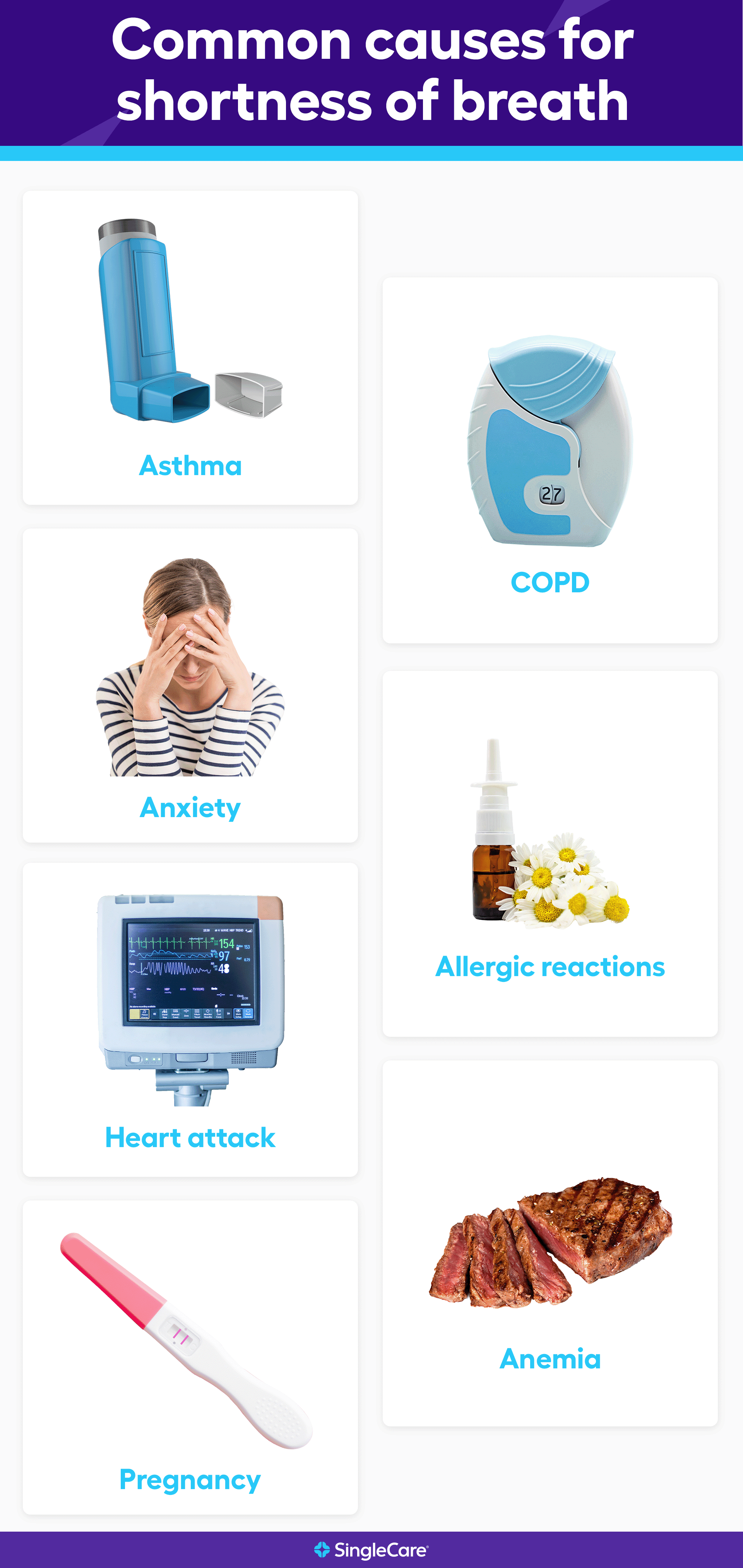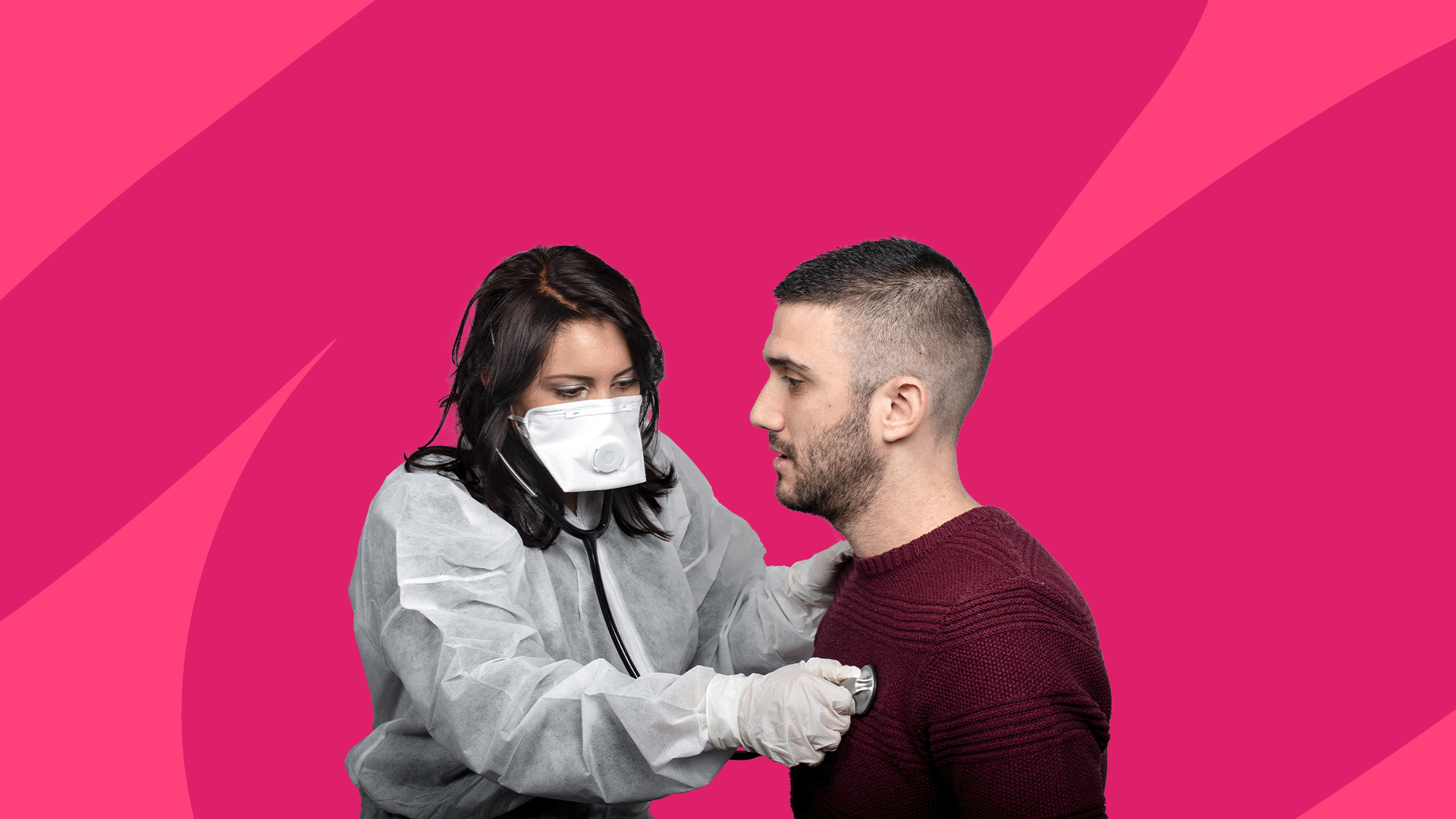Overview: What does shortness of breath feel like?
There are times when you just can’t seem to get enough air. The common term is shortness of breath, but healthcare providers call it dyspnea or “difficulty breathing.” That’s what it feels like. You feel like you’re running out of air no matter how hard, fast, or deeply you breathe. People also describe it as air hunger or breathlessness. Gasping, breathing fast, and breathing more deeply are often the responses to the feeling. Shortness of breath can last for a short time, lasting a few seconds or minutes, or be a chronic problem, either staying for days or weeks or repeatedly happening. Often, the cause is harmless. Exercising too vigorously or traveling to a high altitude can cause breathing difficulties. So can a cold shower or cold drink. However, shortness of breath can be a sign of a more serious medical condition or emergency.
What causes shortness of breath?
Shortness of breath is a common condition in part because so many things can cause it. The most common causes of shortness of breath are lung conditions, heart conditions, and upper airway breathing problems. However, other issues can cause dyspnea, including nerve and muscle problems, psychological problems, poisoning, and other medical conditions.

The list of lung conditions that cause shortness of breath is very long. These include:
Asthma
Chronic obstructive pulmonary disease (emphysema or chronic bronchitis)
Pneumonia
Bronchitis
Allergic reactions
Aspiration of foreign material into the lung
Panic attack or anxiety
Lung cancer
Pulmonary embolism (blockage of the artery to the lungs by a blood clot)
Air around the lung (pneumothorax)
Water in or around the lung (pleural effusion)
Sarcoidosis
Pulmonary hypertension
Interstitial lung disease
Pulmonary fibrosis
The most common heart problems that can bring on dyspnea include:
Throat and neck problems can also cause difficulty breathing, including:
Throat infections
Choking
Croup
Angioedema (allergic reaction swelling of the face, mouth, throat, and neck)
Anaphylaxis (extreme allergic reaction)
Vocal cord dysfunction
Cancer
Injury
Swelling of the flap at the opening to the windpipe (epiglottitis)
Causes of shortness of breath also include nerve and muscle problems such as:
Chest trauma or fractures
Obesity
Central nervous system dysfunction
Muscle damage
Nerve damage
Myasthenia gravis
Amyotrophic lateral sclerosis (ALS)
The most common psychological cause of shortness of breath is anxiety. Panic attacks, stress, or excessive worry can cause people to feel out of breath and compensate by breathing fast or irregularly.
Poisoning is a possible cause of shortness of breath. Toxic causes of shortness of breath include:
Eating poison
Aspirin overdose
Carbon monoxide poisoning
Carbon dioxide buildup in the blood
Dangerously high levels of thyroid hormone
Diabetic ketoacidosis
Metabolic acidosis
Kidney failure
Other causes of shortness of breath include:
Should I be worried about shortness of breath?
Shortness of breath could be nothing or a sign of a serious illness like a heart attack, heart failure, or a severe allergic reaction. Get emergency medical care if shortness of breath is severe and there are other symptoms such as:
Signs that the body is not getting enough oxygen such as an inability to function, pale and clammy skin, racing heartbeats, slow heartbeats, or blue skin
Signs of a serious allergic reaction such as swelling of the face, lips, throat, or mouth, difficulty swallowing, lightheadedness, fainting, fast heart rate, weak pulse, or low blood pressure
Signs of a serious heart problem such as chest pain, nausea, pain in the shoulder, neck, back, or jaw, swelling in the extremities, or fatigue
Any bleeding accompanied by signs of significant blood loss, including pale skin, fatigue, and dizziness
In many cases, shortness of breath could be a sign that medical advice or help is needed:
Shortness of breath happens suddenly for no apparent reason
Shortness of breath lasts for days, weeks, or longer
Shortness of breath keeps coming back
Shortness of breath occurs when lying down but gets better when sitting up
There are other symptoms
You’re worried
How is the cause of shortness of breath diagnosed?
Since there are so many causes, diagnosis can involve some detective work. However, a few things can be expected in the process.
The clinician’s first concern is breathing. Is the person getting enough oxygen? Oxygen can be assessed through vital signs as well as symptoms. If breathing is a physical problem, restoring breathing is the priority.
Once over that hurdle, the clinician will take a detailed medical history and perform a physical examination. Expect to answer questions like:
When did this first occur?
How long did it last?
What were you doing at the time?
Has it happened again? How often?
Is breathing difficult when working? Resting? Lying down?
Are there other symptoms like cough or sore throat?
Has anything helped improve your symptoms?
A physical examination will assess how well the person is breathing. To look for the cause, the clinician will listen to the lungs and the heart and look for other physical signs, and blood tests will be ordered to identify particular medical conditions that may cause the symptoms. The medical provider may also order chest X-rays, an electrocardiogram (ECG), or an echocardiogram if heart problems are suspected. Other tests include lung function tests or a CT scan of the lungs.
RELATED: What are normal oxygen levels?
Is shortness of breath contagious?
If an infection causes shortness of breath, then that infection may be contagious. However, shortness of breath is not itself contagious.
RELATED: Is pneumonia contagious? Who is at risk and how to prevent it
How long does shortness of breath last?
Shortness of breath can last a few seconds, minutes, or hours and then be gone. Called acute dyspnea, the breathing difficulty can be caused by anything from harmless to life-threatening. Alternatively, chronic shortness of breath can go on for days or weeks, either not letting up or in repeated episodes. The most common causes of chronic dyspnea are asthma, COPD, pneumonia, heart failure, anxiety disorders, and interstitial lung disease.
How to stop shortness of breath
The first and overwhelming goal of treatment is to make sure the person is breathing normally and adequately. That may require emergency treatment for some people.
If there is no breathing crisis, the question isn’t how to treat shortness of breath but how to treat a potentially more serious problem. Treatments and their effectiveness will vary depending on the condition.
In some cases, however, treatments that target breathing problems will be the principal treatments. For asthma and COPD, short-acting bronchodilators, inhaled corticosteroids, long-acting beta-agonists, and anticholinergics are all medicines that open airways or prevent them from closing.
RELATED: How to use your inhaler
Living with shortness of breath
If shortness of breath is a chronic problem, no matter what the cause, a few home therapies can help. Healthcare professionals and physical therapists often start by teaching breathing exercises to improve breathing and people’s control over breathing:
Pursed lips breathing: Sit upright, relax, and breathe slowly through your nose. Then take twice the time to breathe out through pursed lips
Belly breathing: Sit or lie down, place your hand on your abdomen to be aware of how the diaphragm moves when breathing, then slowly breathe in and take two to three times longer to breathe out through your mouth.
4-7-8 breathing: often advised for people with anxiety, 4-7-8 breathing involves sitting in a relaxed position and then breathing in for four seconds, holding the breath for seven seconds, and then breathing out for eight seconds for a total of four breaths
More simply, take time to practice taking deep breathing or inhaling and exhaling following a count
Lifestyle changes can also help, especially if chronic lung problems are the cause:
Relaxation techniques can also help. That’s because even when shortness of breath has a physical cause, the emotional response plays a crucial role in the severity of the episode.
Finally, simple breathing techniques can both improve breathing and help manage shortness of breath:
RELATED: 7 home remedies for asthma—and what to do if they don’t work
FAQs about the causes of shortness of breath
What causes shortness of breath with normal oxygen levels?
Shortness of breath may not compromise oxygen levels. Keep in mind that dyspnea is a subjective symptom, not a physical symptom. Though shortness of breath may make you feel like you’re not getting enough air, that’s not always the case. Exercise, anxiety, panic, and allergic reactions are common causes of shortness of breath but don’t compromise breathing. The same applies to a heart attack, anemia, blood loss, or heart failure. Dyspnea caused by heart problems is due to poor blood circulation and insufficient oxygen reaching the body’s tissues. The body compensates by quickening and deepening its breathing.
What causes shortness of breath when walking?
Walking does increase the body’s need for oxygen, so it’s more likely to cause shortness of breath than sitting or sleeping. However, there’s nothing distinctive about shortness of breath brought on by walking. It has many of the same causes as shortness of breath in any other situation. The most common causes of shortness of breath due to physical exertion include poor physical condition, obesity, asthma, COPD, and anxiety.
What causes shortness of breath when lying down?
People can experience shortness of breath when walking, standing, sitting, or lying down. However, when lying down seems to cause shortness of breath that then gets better when sitting up, this is very significant. It’s usually caused by fluid in the lungs (pulmonary edema), a symptom of a potentially serious medical condition. Medical help is needed.
What causes chest pain and shortness of breath?
Some conditions that cause shortness of breath can also cause chest pain. The most common are anxiety, heart attack, pneumonia, COPD, heart failure, fluid in the lungs, and others. The nature of the pain, however, will differ depending on the cause.
What causes wheezing and shortness of breath?
Wheezing is noisy breathing. Inhaling or exhaling produces a distinctive whistle, growl, or rattle, as if a lot of effort is involved. It’s usually due to some airway obstruction, so it has many of the same causes as shortness of breath, particularly asthma, COPD, and pneumonia. People who breathe very rapidly often wheeze. So wheezing can be brought on by any condition that causes fast breathing, including heart problems or overexertion.

